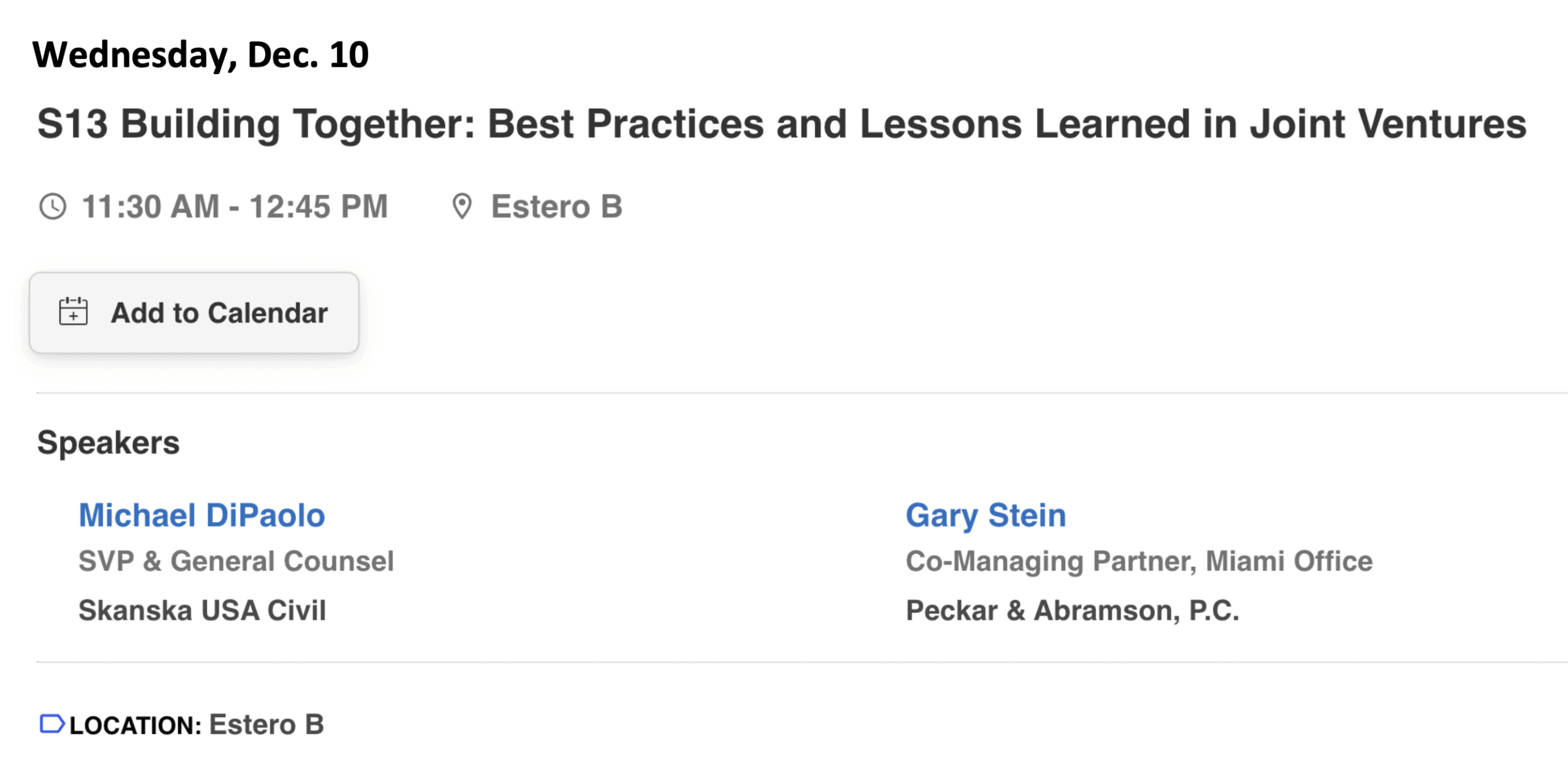BONITA SPRINGS, FL – Joint ventures within the construction industry are not going away. At a minimum, Gary Stein, co-managing partner at Peckar & Abramson, sees the number of ventures remaining steady in the new year. “However, they may be on the increase,” he says, “because they are viable models for larger projects where contractors want to share the risk, or in situations where they don’t have enough resources.”
Along with Michael DiPaolo, senior vice president and general counsel, Skanska USA Civil, Stein will explore the joint venture (JV) topic when Construction Super Conference convenes Dec. 9-11 at the Hyatt Regency Coconut Point, Bonita Springs, Fla. Third Thursday sat down with Stein to learn more about the issues that he and DiPaolo plan to cover on Wednesday, Dec. 10.
 Third Thursday: What are some basic JV concerns?
Third Thursday: What are some basic JV concerns?
Stein: It’s important to make sure that you’re partnering with somebody who can hold up his or her end of the bargain, and also who shares a similar management style. It’s also important that you focus on how you make important management decisions during the project. For example, if there are two joint venture partners, does there have to be a unanimous decision? What do you do if the two partners can’t agree? How do you deal with tiebreakers? If there are three JV partners, is it going to be a majority vote? Is it going to have to be unanimous? And if you can’t achieve unanimity, how do you break the tie so that the JV can effectively transact business?
Third Thursday: How do you know if you have the right JV partner?
Stein: It’s not a one-size-fits-all scenario. Sometimes the joint ventures that I see are created because the parties had worked together previously, or sometimes they get along at the project level and at the executive level. When they have never worked together, they spend a lot of time getting to know each other and they do a lot of behind-the-scenes vetting.
Third Thursday: Any recent court decisions that you plan on dissecting?
Stein: One case we will likely talk about was tried in federal court in the middle district of Orlando, Fla., entitled Lane Construction versus Skanska Granite Construction and SGL. It was a legal dispute between and among joint venture members where the court had to interpret a comprehensive and detailed joint venture agreement—and resolve disputes between and among joint venture partners.

Third Thursday: Will joint ventures continue to be a hot issue in 2026?
Stein: I think it will because I don’t see a decrease in the number of joint ventures. At a minimum it’s remaining steady and may be on the increase because it’s a viable model for larger projects where contractors want to share the risk—or in situations where they don’t have enough resources.
Third Thursday: Any other reasons to pursue these ventures?
Stein: Construction companies may want to go into different geographic markets where they don’t have experience and team up with somebody who does have experience in that market. It may be a good opportunity to joint venture with another contractor who can help with the learning curve on a new project.
Third Thursday: Any other hot topics on the horizon?
Stein: Tariffs are going to continue to impact the construction community, and it’s something that will be closely followed, as well as what’s going on with immigration. The construction industry, at least in some jurisdictions, relies on labor markets that are heavily filled by immigrants. We’ll see how immigration policies impact the labor supply, and how tariffs are going to affect the ability to purchase materials overseas.
 Third Thursday: Why are in-person conferences still relevant in the digital age?
Third Thursday: Why are in-person conferences still relevant in the digital age?
Stein: There’s something different that occurs when you’re interacting with people in-person. There’s a different dynamic—a different energy. It facilitates cooperation and collaboration, and you develop relationships. It’s a lot easier to resolve disputes if you have working relationships. CSC is a good opportunity to get to know people and even meet potential clients for business development. There’s a certain thing that happens when you’re meeting with somebody personally as opposed to during a call or a video conference. You have an opportunity to meet other lawyers who you may want to work with going forward.

